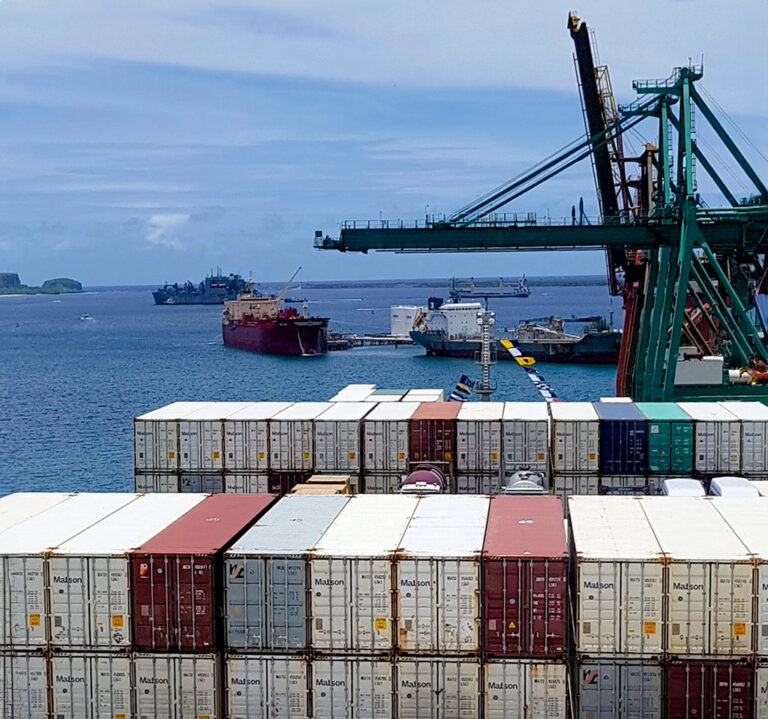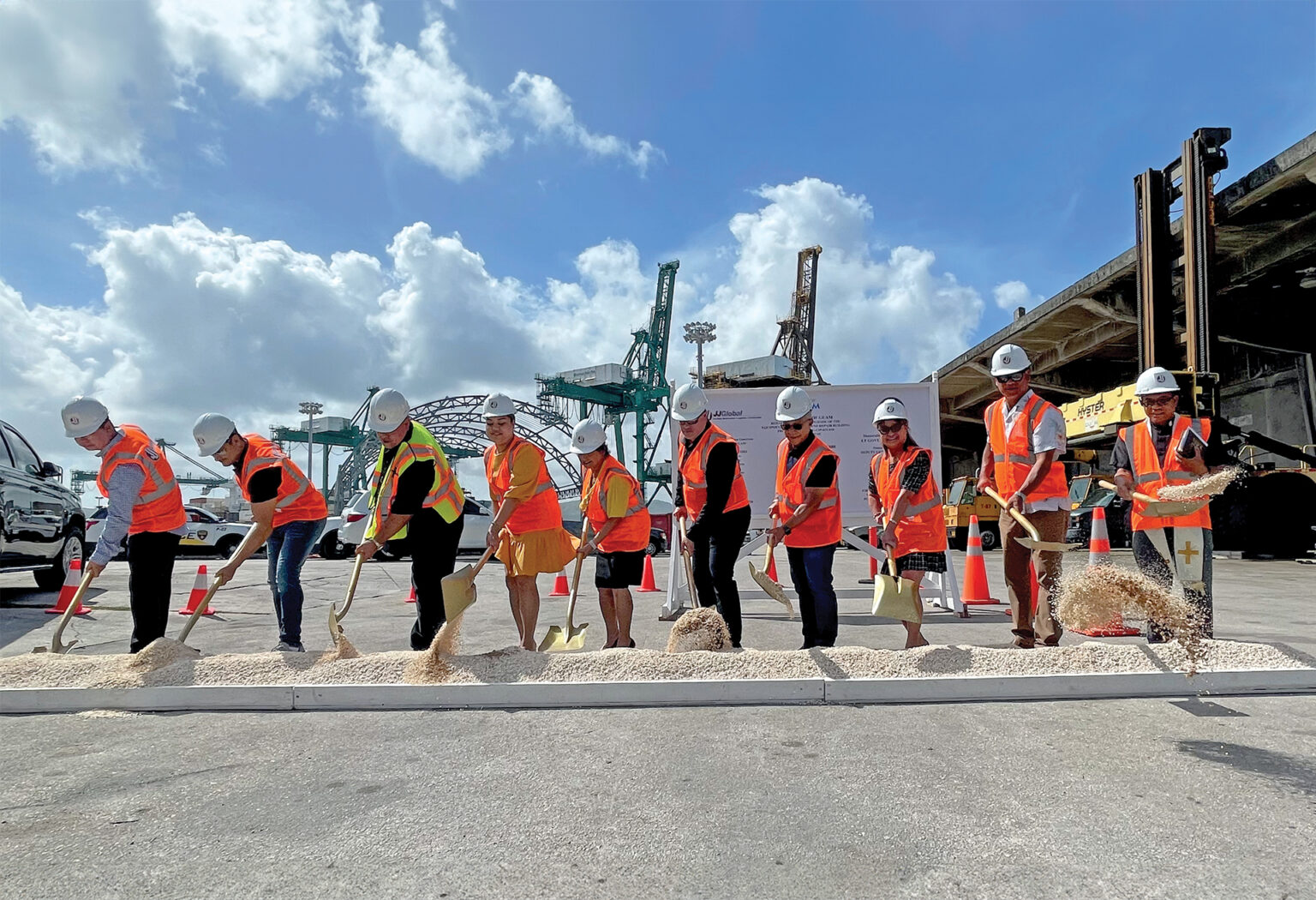
Modernization plans by the Port Authority of Guam (PAG) are kicking into high gear as the U.S. Department of Defense (DOD) accelerates construction activity on the island.
Rising geopolitical tensions in the region, which resulted in the increased military buildup, underscore Guam’s crucial role in homeland defense, says PAG General Manager Rory Respicio.
“We provide critical support to the nation’s readiness when deploying military assets for not only the Guam military buildup, but for the entire Indo-Pacific strategy,” he says.
A VITAL ROLE
Guam’s lone commercial port provides the Western Pacific region with vital global supply chain access.
“Approximately 30 percent of the total cargo currently moving through the Port Authority of Guam is military-related,” Respicio says. “During the peak of the military buildup, additional imported military equipment, supplies and construction-related materials are expected to nearly double the port’s military cargo volumes.”
The $11 billion military buildup stems from a 2006 agreement between Washington and Tokyo, which calls for the relocation of 5,000 Marines from Okinawa to Guam.
“The U.S. Marine Corps has reported that up to 134 projects are directly associated with the realignment efforts, with many currently ongoing or pending,” Respicio says.
Along with defense construction related to the Marines’ transfer, U.S. Indo-Pacific Command is also proposing to build a $1 billion missile defense system on Guam, while the U.S. Air Force is preparing to develop training facilities at Andersen Air Force Base for Singaporean F-15 fighters.
The DOD estimates approximately $8 billion in spending during fiscal years 2021 through 2029 for Guam military buildup and training facilities in the Northern Marianas, compared to an average of $300 million a year for the past eight years. The DOD obligated $530 million in Fiscal Year 2020 and $402 million in FY2021 for construction projects linked to troop realignment.
“Port operations contribute to the overall quality of life by ensuring that consumer goods, construction materials and other essential supplies are consistently available,” Respicio says.
MULTIPLE UPGRADES PLANNED
The port chief notes that fulfilling the agency’s mission necessitates “the highest standards of operational resiliency, readiness and efficiency,” hence the need to upgrade its infrastructures.
Among the PAG’s largest projects that are part of its modernization plan is wharf rehabilitation and access roadway repairs, estimated at $92.6 million. The project involves phased rehabilitation of the wharf structure with a new bulkhead, modern mooring and fendering system, utilities and pavement. According to the Office of Public Accountability’s June 2024 audit report, “the design phase is 95 percent complete, and the next step is construction.”
The authority launched two systems upgrade projects last year. In March 2023, contractor BME & Sons Inc. began work on a $4.8 million waterline replacement and relocation project, which was fully funded through revenue bonds issued in 2018.
“Replacing existing waterlines will relocate the main service feed line and address the 15 major leaks identified in the past three years,” Respicio said during a groundbreaking ceremony held last year. “The new waterlines will provide redundancy and improve water pressure to meet local building codes, National Fire Protection Association requirements and U.S. Coast Guard requirements for firefighting operations.”
The following month, the PAG broke ground on rehabilitation and upgrades at its Equipment, Maintenance and Repair (EQMR) Building and Warehouse 1, which houses heavy equipment such as forklifts, transportation fleets, cargo handling equipment and tractors.
“We are doing what we can to extend the service life of these facilities,” Respicio says.
Repairs and upgrades are intended to harden 79,000 square feet of warehouse space. According to the project’s description, structural repairs will address existing cracks and spalling that affect overall structural integrity and pose hazards to personnel working within the facilities. JJ Global Services is completing the work.
The $3.1 million project also includes repairs to mechanical and electrical systems within the EQMR Building, upgrades to its fire protection system and inspection and replacement of corroded reinforced steel in Warehouse 1. This portion of the project is being performed by IAN Corp.
TYPHOON MAWAR’S EFFECTS
The devastating Typhoon Mawar, which hit Guam last May, posed temporary setbacks to port operations.
Respicio says Mawar significantly damaged Golf Pier, one of Guam’s only two fuel piers, along with its shoreline, bulkhead and riprap. The damage has rendered the facility inoperable, with the replacement of Golf Pier estimated to cost approximately $83 million.
“Other major areas affected by the storm were the F1 through F6 wharves, with notable damage to the sheet pile wall at F3 and the concrete bulkhead of F4 through F6,” Respicio says.
He says the port has repaired most of the damage to its buildings and replaced vital equipment, but it continues working with the Federal Emergency Management Agency regarding scope, costs and repairs to restore full recovery of port operations.
Among related projects are replacement of the F1 pier, which costs $84 million, and hardening of Wharves F2 through F6, estimated at $22.4 million.

AGING CRANES
The port’s three 40-year-old gantry cranes pose an equipment challenge that may compromise its operations.
“Based on consultant reports, they’ll reach the end of their expected service life and will need to be replaced in a few years,” Respicio says. “The three cranes can meet the forecast demand for the Department of Defense buildup. But if just one of those cranes goes out of service before replacement, it will delay the military buildup by four years.
“If two of those old cranes go out of service, the port would not be able to meet commercial demand or the DOD mission,” he adds.
The PAG plans to acquire three rail-mounted ship-to-shore gantry cranes at a cost of about $60 million. For the past several years, however, the port agency’s plans have been hampered by federal rules.
“Because this equipment has not been made in the United States since the 1980s, the PAG has attempted to apply for waivers through federal grant programs to acquire the needed equipment,” Respicio says. “Despite numerous federal agencies providing waivers to the Build America Buy America requirements for Pacific Island territories, these waivers have expressly excluded the purchase of STS [ship-to-shore] gantry cranes.”
In June, the authority submitted a grant request to the Office of Local Defense and Community Cooperation’s Defense Community Infrastructure Program for $19.9 million to fabricate and install a rail-mounted ship-to-shore gantry crane, and is currently soliciting bids to acquire another crane purchased with port funds.
“We recognize that the replacement of STS gantry cranes is critically needed for the Port of Guam to maintain its operational and financial sustainability to properly service the military buildup and future mission capabilities on Guam and within the Mariana Islands,” Respicio says.




